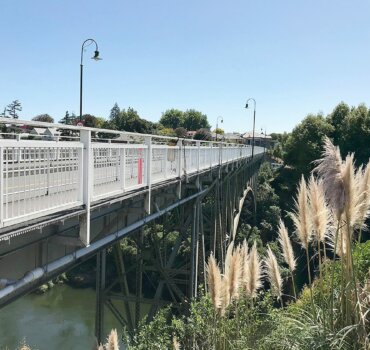
The high-level bridge

The high-level bridge
Cambridge’s Victoria Bridge has passed its latest warrant of fitness – but it will require work to ensure it passes the next one.
Concerns have been raised about the state of the century old bridge.
A structural assessment report from consultants, presented to Waipā District Council’s Service Delivery Committee has indicated it is in fair condition under existing weight limits but further work will be required to maintain that rating.
Council’s Transportation Manager Bryan Hudson said the team undertook regular assessments of the historic bridge and programmed in any required maintenance as indicated in the assessments.
“The most recent Beca structural assessment has shown that the current weight limits on vehicles crossing the bridge are suitable for today’s use but it has highlighted areas that we will need to repair and repaint in order to maintain the bridge’s lifespan.
“We are planning to undertake these repairs and the repainting programme during 2022-2023. During repair and repainting, significant scaffolding will be required on the structure and we will need to manage traffic during the repairs to accommodate this additional temporary load,” said Hudson.
Findings from the report indicate that the Victoria Bridge’s structural capacity will continue to provide service under current usage and vehicle weight restrictions with no strengthening required. The bridge’s current vehicle weight restriction of three tonnes will be maintained as the bridge does not have capacity to accommodate a lane full of heavy trucks.
Councillor Roger Gordon noted his concerns at some of the wording used in the reports, which indicated parts of the bridge were in a ‘deteriorated’ condition.
“The report does include a lot of technical jargon which can unfortunately be misinterpreted if you aren’t familiar with these type of technical reports.
Having this rating isn’t uncommon on bridges of any age where weight limits need to be applied as they are rated against a wide range of traffic loads including vehicles and pedestrians, all the way through to heavy trucks and trailers,” Hudson explained.
Gordon was concerned at images in the report which showed areas of corrosion on the underside of the bridge. Hudson confirmed that the images showed information typical of a historic bridge and the many photographs taken by rope access helped to plan the work ahead for the repair and repainting stages.
Hudson advised that the steelwork repairs identified in the report will be made prior to repainting and this will prolong the life of the bridge.








